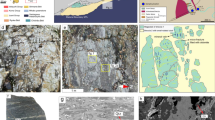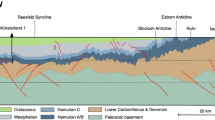Abstract
An unusual structural paragenesis, complicated by brachyanticlines, is revealed for the first time in the sedimentary cover of the West Siberian Plate by 3D seismic surveying. These are linear (in plan view) systems of en-echelon arranged low-amplitude normal faults related to wrench faults in the basement. On different sides off a wrench fault, the planes of normal faults dip in opposite directions, forming a helicoidal structure that resembles the blades of a propeller. In the section parallel to the wrench fault, the boundaries of the beds and normal fault planes dip in opposite directions as well. In the section across the strike of the normal faults converging toward the basement, the beds take the shape of an antiform with a crest sagged along the normal faults (flower structure). This structural assembly was formed as a result of interference of stress fields of horizontal shear in the vertical plane (induced by faulting in the basement) and in the horizontal plane (caused by gravity resistance of the cover). In this case, the displacements along the normal faults develop in both the vertical and, to a greater extent, horizontal directions, so that the faults in cover are actually characterized by normal-strike-slip kinematics. The regional N-S-trending compression of the West Siberian Plate is the main cause of shearing along the NW- and NE-trending faults in the basement, which make up a rhomb-shaped system in plan view. Petroliferous brachyanticlines, whose axes, notwithstanding tectonophysical laws, are oriented in the direction close to the maximum compression axis, are known in the large wrench fault zones of Western Siberia. Our experiments with equivalent materials showed that a local stress field arising at the ends of echeloned Riedel shears within a wrench fault zone may be a cause of the formation of such brachyanticlines. The progressive elongation of Riedel shears leads to the corresponding elongation of the brachyanticlines located between their ends. The performed study has shown that the known types of interference of elementary geodynamic settings such as horizontal shear along the vertical plane + horizontal compression (transpression) and horizontal shear along the vertical plane + horizontal extension (transtension) may be supplemented by combination of horizontal shears along the vertical and horizontal planes, resulting in tectonic lamination. By analogy, we propose to name this type of interference of elementary shear settings translamination. Petroliferous helicoidal structures arise in the given geodynamic setting of translamination.
Similar content being viewed by others
References
V. V. Belousov, Structural Geology, 3rd Ed. (Moscow State Univ., Moscow, 1986) [in Russian].
V. V. Belousov, M. A. Goncharov, and V. G. Talitsky, “A Concept on Structural Parageneses,” in Mechanisms of Structure Formation in the Lithosphere and Seismicity (Inst. Physics Earth, Moscow, 1991), pp. 157–158 [in Russian].
S. A. Bornyakov, “Tectonophysics of a Transform Zone in the Elastoviscous Model,” in Fault Tectonics (Nauka, Novosibirsk, 1981), pp. 26–44 [in Russian].
G. N. Gogonenkov, A. S. Kashik, and A. I. Timurziev, “Strike-Slip Faults in Basement of Western Siberia,” Geol. Nefti Gaza, No. 3, 3–11 (2007).
M. A. Goncharov and V. G. Talitsky, “Do Shear Fractures Originate by Shearing?” Vestn. Mosk. Univ., Ser. 4 Geol., No. 3, 18–22 (1998).
M. A. Goncharov, V. G. Talitsky, and N. S. Frolova, Introduction to Tectonophysics (Knizhnyi Dom Universitet, Moscow, 2005) [in Russian].
M. A. Goncharov and N. S. Frolova, “Paradox of Orientation for Some Recent Petroliferous Brachyanticlines in Shear Zones along Maximum Compression Axis: Tectonophysic Interpretation,” in General and Regional Tectonics and Geotectonics (Geos, Moscow, 2008), Vol. 1, pp. 218–222 [in Russian].
M. A. Goncharov, N. S. Frolova, P. N. Rozhin, and N. N. Selezeneva, “An Issue of Absolute Kinematics of Opposite Fault Walls,” Vestn. Mosk. Univ., Ser. 4 Geol., No. 4, 12–19 (2007).
A. V. Luk’yanov, Ductile Deformation and Tectonic Flow in the Lithospherte (Nauka, Moscow, 1991) [in Russian].
O. V. Lunina, A. S. Gladkov, and S. I. Sherman, “Variations of Stress Fields in the Tunka Rift of the Southwestern Baikal Region,” Geotektonika 41(3), 69–96 (2007) [Geotectonics 41 (3), 231–257 (2007)].
A. V. Mikhailova, “Geodynamic Characteristics of the Structures Formed in a Layer above Active Faults in Basement,” in Geophysics in the XXI Century: 2006 (GERS, Moscow, 2007), pp. 111–118 [in Russian].
Yu. A. Morozov and T. M. Geptner, “Comparison of Natural and Experimentally Reproduced Structural Assemblies Formed under Conditions of Transpression and Transtension,” in Evolution of Tectonosphere (Inst. Physics Earth, Moscow, 1997), pp. 219–258 [in Russian].
Geology and Development of Unique Gas Pools in the Extreme North of Western Siberia, Ed. by O. M. Ermilov, Yu. N. Karogodin, A. E. Kontorovich, et al. (Siberian Branch, Russian Acad. Sci., Novosibirsk, 2004) [in Russian].
V. D. Parfenov and S. D. Zhukovsky, “Modeling of Brittle Failure under Conditions of Shearing,” Geotektonika 1(4), 112–117 (1966).
S. I. Sherman, K. Zh. Seminskiy, S. A. Bornyakov, et al., Fracturing in the Lithosphere. Shear Zones (Nauka, Novosibirsk, 1991) [in Russian].
Yu. L. Rebetsky, “Heterogeneity of the State of Stress in Zones of Horizontal Shearing and Its Manifestation in Secondary Fracturing,” in General and Regional Tectonics and Geotectonics (Geos, Moscow, 2008), Vol. 2, pp. 154–158 [in Russian].
E. A. Rogozhin, A. R. Ovsyuchenko, A. V. Marakhanov, and E. A. Ushanova, “Tectonic Setting and Geological Manifestations of the 2003 Altai Earthquake,” Geotektonika 41(2), 3–22 (2007) [Geotectonics 41 (2), 87–104 (2007].
K. Zh. Seminsky, Internal Structure of Continental Fault Zones: Tectonophysical Aspects (Geo, Novosibirsk, 2003) [in Russian].
S. Stoyanov, Formation Mechanism of Fault Zones (Nedra, Moscow, 1977) [in Russian].
V. S. Surkov and O. G. Zhero, The Basement and the Evolution of Platform Cover of the West Siberian Plate (Nedra, Moscow, 1981) [in Russian].
A. I. Timurziev and G. N. Gogonenkov, “Structural and Tectonic Characterization of the Basement of Strike-Slip Fault Zones in the Yetypur Swell,” Geol. Nefti Gaza, No. 6, 2–10 (2007).
G. H. Davis, A. P. Bump, E. Pilar, P. E. Garcia, and S. G. Ahlgren, “Conjugate Riedel Deformation Band Shear Zones,” J. Struct. Geol. 22, 169–190 (1999).
T. Dooley and K. McClay, “Analog Modeling of Pull-Apart Basins,” Am. Assoc. Petrol. Geol. Bull. 81(11), 1804–1826 (1997).
K. McClay and M. Bonora, “Analog Models of Restraining Stepovers in Strike-Slip Fault Systems,” Am. Assoc. Pet. Geol. Bull 85(2), 233–260 (2001).
M. A. Naylor, G. Mandl, and C. H. K. Sijpesteijn, “Fault Geometries in Basement-Induced Wrench Faulting under Different Initial Stress States,” J. Struct. Geol. 8, 737–752 (1986).
G. Schreurs, “Experiments on Strike-Slip Faulting and Block Rotation,” Geology 22, 567–570 (1994).
G. Schreurs and B. Colletta, “Analogue Modeling of Faulting in Zones of Continental Transpression and Transtension,” in Continental Transpressional and Transtensional Tectonics, Ed. by R. A. Strachan and J. F. Dewey (Geol. Soc. Spec. Publ., London, 1998), Vol. 135, pp. 59–79.
A. G. Sylvester, “Strike-Slip Faults,” Bull. Geol. Soc. Am. 100, 1666–1703 (1988).
K. Ustaszewski, M. E. Schumacher, S. M. Schmid, and D. Nieuwland, “Fault Reactivation in Brittle-Viscous Wrench Systems-Dynamically Scaled Analogue Models and Application to the Rhine-Bresse Transfer Zone,” Quaternary Sci. Rev. 24, 365–382 (2005).
Author information
Authors and Affiliations
Corresponding author
Additional information
Original Russian Text © N.V. Koronovsky, G.N. Gogonenkov, M.A. Goncharov, A.I. Timurziev, N.S. Frolova, 2009, published in Geotektonika, 2009, No. 5, pp. 50–64.
Rights and permissions
About this article
Cite this article
Koronovsky, N.V., Gogonenkov, G.N., Goncharov, M.A. et al. Role of shear along horizontal plane in the formation of helicoidal structures. Geotecton. 43, 379–391 (2009). https://doi.org/10.1134/S0016852109050033
Received:
Published:
Issue Date:
DOI: https://doi.org/10.1134/S0016852109050033




